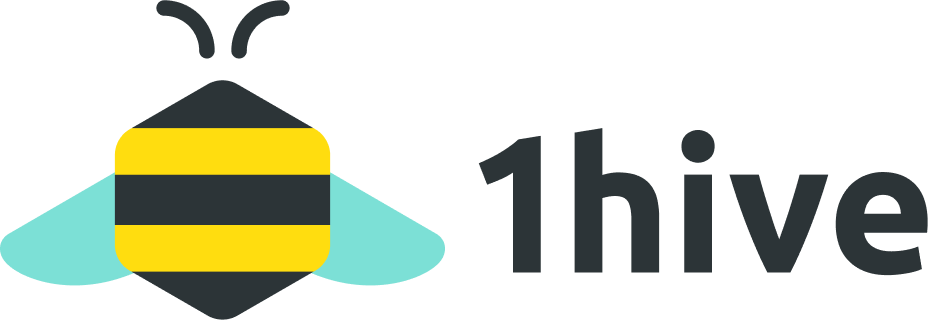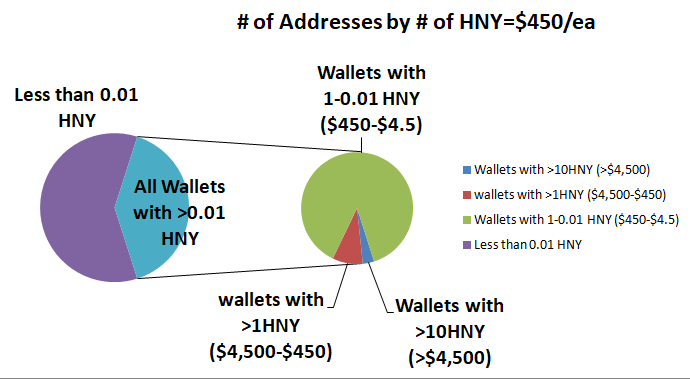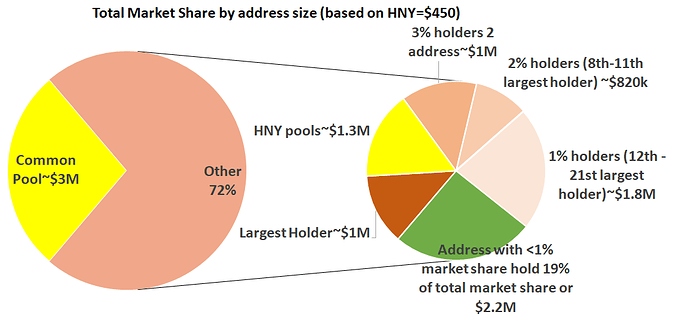A brief history of honey
This topic came up on the Discord this morning and I shared some history and background information on the honey distribution. But it was asked that I share a summary here as well.
1Hive has been experimenting with DAOs for quite a while, the first iteration was on Rinkeby. You can see the Aragon DAO here. At the time we were using a membership model with a contributor token (Honey), we didn’t have any capital, so we issued Honey and distributed it to people who contributed to the projects we were working on. It didn’t really have any financial value at the time, but it carried social value within the community. We knew the model wasn’t perfect, we just wanted to dogfood daos and see if we could figure out how to make this new form of community organization work. We tried a lot of different processes, The mechanism that worked best for us was a periodic “nominations” + dot voting. We set a budget and distributed honey on a regular bases using Honey weighted dot-voting, if someone did something cool in the community someone would nominate them, and they would be added to the vote. Existing honey holders could distribute their voting weight across all nominees, and then each nominee would get a proportion of the budgeted honey based on these votes.
Once we found this process we realized that it just felt good, people contributed organically and then had those contributions be recognized and rewarded by others without having to pre-negotiate as fun and engaging, rather than feeling like work. People could be creative and take initiative, determining for themselves how they wanted to contribute and what would provide the most leverage.
Additionally, because we had set a budget for the allocation and then simply weighted it by token holding there was minimal argument surface about the relative value of various contributions. In some weeks lots of awesome stuff happened and each contribution received less honey, and some weeks there was a standout contribution that that got a large portion of that weeks honey.
Eventually we decided to move our DAO from rinkeby to https://client.aragon.org/#/beehive/0x40740b2b63d835119acc417309c59bde9e5c43e3/. Besides feeling more real, some of the consistent contributors had started to work on grants, with the introduction of real money we had new challenges around treasury management and processes and legal requirements. We had treated the rinkeby organization as a test org, but had set the expectation early on that we intended honey balances to be carried over to whatever iteration and experiment happened next so long as it made sense to do so.
After further iteration there seemed to be a pretty natural split, where the 1hive community dao continued to function primarily with Honey using the nominations and allocation process. But we now had grants with specific deliverables and legal expectations and so we needed to have tighter processes. We found that these processes didn’t scale in the same way, we needed to be able commit to deliverables and take on liability to engage with clients or grant providers, and we couldn’t do that well if resources were flowing in a more ad-hoc nature. We also found that we couldn’t onboard people fluidly, because we needed to manage our resources much like a traditional company would. Essentially we started to see the emergence of what the 1hive model looks like today, a larger community with smaller groups that are more tightly coordinated in the periphery.
As gas costs increased on mainnet it became apparent that our existing processes for distribution of honey to community members was not tenable. At one point it cost over 100 dollars just to create the dot vote, and was similarly expensive for each person voting. We had also depended on that initial seed group to mint and set up the dot votes, and this felt like a bug and not a desirable feature, we had been working on more sophisticated mechanisms to avoid that were just getting to the MVP stage, and so we decided to take the relatively large step of iterating on the honey issuance and distribution process and at the same time migrate to xDai. You can read more about that in the annoucement post about the migration.
In order to migrate to xdai we had to setup and deploy all of the Aragon dao infrastructure, we also had been using uniswap to provide liquidity to honey on Ethereum, and so we also deployed uniswap v1 during the migration. At the point of the migration there were only around ~45 honey holders. It was a much smaller community. After the migration and announcement we saw a steady increase as we participated in hackathons like dao hack month (where we created the faucet), and dao rush week, the conviction pilot with aragon and block science, and of course honeyswap. After the omnibridge and honeyswap launched, a random person I had never talked to wrote a guide on how to bridge dai and buy honey on honeyswap, and started shilling the article. After that we had parabolic growth, as more people found out they created more content and videos, shared it with their friends, and we had a huge influx of people and capital into the community.
This influx was extremely rapid, we went from somewhere like 200 accounts, to currently over 8000 holding honey, and we went from Honey being around 50 dollars to where it is currently ~1100 dollars. The initial spike was on relatively low liquidity, but since then liquidity has been growing consistently while price has still been fairly healthy. Without doing deep analysis, this likely means that some of the existing community members are selling, and they are also providing liquidity, making it easier for others to get in and out of positions, rebalance their portfolios, without impacting price significantly.
Beyond simply an influx of capital, we have seen an influx of people, in my opinion the most valuable asset a DAO has its its community and its culture. A rapid influx of people is challenging for a community, because it takes time for values, social norms, and culture to be propagated to new community members. Community health and culture is of paramount importance, it’s more important than short term price movements, and more important than honeyswap, because community and culture are the only moat that matters for decentralized networks. Liquidity flows to where things are most profitable, open source software can be easily forked and redeployed, it’s the community values, norms, social structures and history that make things like Ethereum and Bitcoin valuable, not the underlying technology codebase.
I say all this to provide context, because I think that what we are doing here is unique. It’s not surprising that when new people come in and learn about 1hive they try and match it to existing patterns, but we don’t really fit that mold. We didn’t do a ICO, we didn’t do a pre-mine, we haven’t ever raised funds, there isn’t a core team, and we are all individuals that have aligned around common values and shared interest. We have been a community project since day one, it just happens to be that we have experienced parabolic growth both in terms of people and capital in recent weeks, and people who have been involved in the community before that spike generally have a much greater amount of Honey compared to people who have recently joined the community. As we continue to grow and the 8k honey holders look small when we hit 100k, the people joining now will also have a distinct advantage over those that come later, and if there is a dip in price or interest in the project, the ones with strong hands that stick around and keep contributing will be the ones that end up being rewarded most in the next cycle. Markets ebb and flow, and I’m never going to tell anyone in the community when they should buy or sell, but we are building a resilient community that goes way beyond just a dex on xdai, or any specific initiative.
With all that said, I do think the current distribution is too concentrated! However, echoing the sentiment shared by others in this thread, I feel strongly against any suggestion or proposal to directly target specific individuals because they have too much honey… Instead we should look for, adopt, and maintain policies which help to push the distribution towards one that is more broadly distributed through positive incentives.
We are still in a community bootstrapping and growth phase, and we have an issuance policy that reflects that. Issuance is a tool that forces circulation, it impacts all holders proportionally, but in this case has a much more pronounced relative impact on original community members, because they are being diluted, and as they are honey is being recirculated to a much wider set of contributors, both those contributing capital (farms), as well as contributing value in other ways (pollen, faucet, and swarm proposals).
We also have farms now, and incentivizing liquidity for the honey against other liquid pairs (like dai and weth) encourages and enables larger holders to sell honey and have it recirculate without causing the price to crash (which is disruptive and not really fun for anyone).
One suggestion was to have people with a lot of honey voluntarilly lock up the honey in a vesting contract, removing the ability for them to vote and creating long term alignment (while also assuaging fears that they might dump and destabilize the market at any point). I think this is interesting, and not opposed to it so long as it is not done through governance but instead done voluntarily, and perhaps there are interesting ways we could incentivize this behavior either directly with honey, or more creatively (perhaps issue an NFT related to locking up tokens).
Whatever ends up being proposed (if anything), I think its important that we don’t create the culture or future expectation that if you contribute and play by the rules and accumulate honey, that at some point in the future some mob of people will decide that you don’t deserve it and coordinate to punish you for it. If we create that sort of culture or set that sort of precedent, there will be no reason to value Honey now or in the future.
This ended up being a bit longer than I expected, and I haven’t really proofread or edited it, so hopefully it adds to the discussion and gives some context about the history and of honey and 1hive, and my perspective on the issue of concentration in the current honey distribution.






